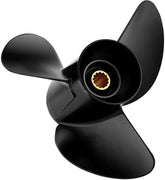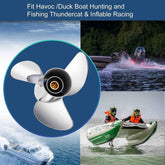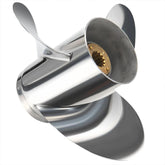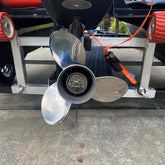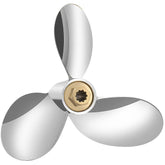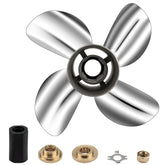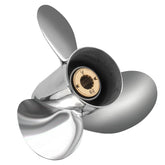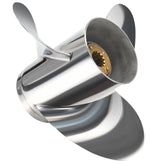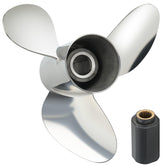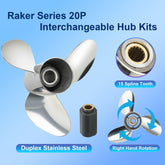The Ultimate Guide to Choosing the Right Propeller for Your Outboard Engine
Selecting the right propeller for your outboard engine can seem daunting at first. Whether you're replacing a worn prop or upgrading to a higher-performance model, making sure you choose the right one is crucial for getting the best out of your boat. A propeller affects everything from acceleration and top speed to fuel efficiency and engine longevity, so understanding how to pick the best one for your engine is essential.
In this guide, I’ll walk you through all the critical factors that influence propeller performance and provide practical advice on how to choose the right prop for Yamaha, Mercury, Honda, or Volvo outboards. Whether you’re a recreational boater or someone who runs a heavy-duty commercial engine, this guide will help you navigate the process with confidence.
At the end of this post, you’ll know how to choose the right propeller based on your engine type, boating conditions, and performance needs, and how VIF Marine can help you find the perfect match for your boat.
Why the Right Propeller Matters
Before you start shopping around for a propeller, it’s important to understand just how much the right choice impacts your boat's performance. The propeller is the link between the engine’s power and the boat’s motion. Choosing the right one can make all the difference in terms of how the boat performs, how efficiently it runs, and how long it lasts.
The wrong propeller can affect:
-
Top Speed and Acceleration: A prop that’s too large or small can limit your boat’s speed and responsiveness.
-
Fuel Efficiency: A prop that isn’t optimized for your boat’s engine will cause your engine to work harder, burning more fuel.
-
Engine Load and Longevity: A mismatched prop can put unnecessary strain on your engine, causing wear and tear over time.
Understanding these factors is key to choosing the right prop. Different boat engines require different types of props, so you’ll need to know your engine's requirements before selecting one. Whether you have a Yamaha, Mercury, Honda, or Volvo engine, there are specific propellers designed to suit each one for optimal performance.
How to Match Your Propeller to Your Engine
Every outboard engine, whether it's a Yamaha, Mercury, Honda, or Volvo, has specific propeller requirements based on the engine’s power, torque, and intended use. Let’s break down what makes a propeller the right choice for your engine.
Yamaha Outboards and Propellers
Yamaha engines are known for their reliability and smooth performance, but choosing the right propeller is still critical. Yamaha props are designed for versatility, offering a range of options for different boat types, from small dinghies to large center consoles.
When choosing a prop for your Yamaha engine, you'll want to ensure it matches the engine’s torque and recommended WOT RPM (wide-open throttle). Yamaha propellers come in both aluminum and stainless-steel options. Aluminum props are great for casual use, while stainless-steel props are best for higher-performance or frequent use due to their increased durability.
Browse VIF's collection of Yamaha propellers to find a prop designed specifically for your Yamaha outboard, ensuring optimal performance on the water.
Mercury Outboards and Propellers
Mercury outboards are designed for speed and high performance, so selecting the right propeller is especially important for maximizing these benefits. Mercury props are known for their high-rpm efficiency and fast acceleration.
Mercury engines benefit from props that help manage high torque output and deliver the right balance of thrust. You’ll often see Mercury boats outfitted with stainless-steel props for their ability to withstand high stresses and provide maximum efficiency.
If you're looking to replace or upgrade your prop for a Mercury engine, check out the Mercury propellers collection at VIF. They offer a range of options to help you get the most out of your engine’s performance.
Honda Outboards and Propellers
Honda outboards are known for their quiet operation and fuel efficiency, making them a great choice for leisure and recreational boating. Honda engines typically require props that focus on smooth acceleration and low-end thrust, rather than extreme top-end speed.
For Honda engines, consider a 3-blade aluminum prop for general use, or a 4-blade stainless-steel prop if you’re looking for additional stability when loaded or during towing. VIF offers a variety of Honda propellers that are specifically matched to Honda outboards.
Volvo Outboards and Propellers
Volvo Penta engines are often used in larger, heavier boats, and require a propeller that can handle the increased load and provide efficient low-speed thrust. When selecting a prop for Volvo outboards, it’s important to choose one that offers high thrust at low speeds for better stability when maneuvering or at anchor.
For these engines, a 4-blade aluminum or stainless-steel prop is usually a good choice. These props provide better grip in the water, especially when the boat is loaded with passengers or gear. You can explore our selection of Volvo propellers to find one that fits your engine and usage needs.
Choosing the Right Material for Your Propeller
Material choice plays a significant role in your propeller’s performance and durability. There are two primary materials to choose from: aluminum and stainless steel.
-
Aluminum: Ideal for casual recreational boating, aluminum props are lightweight, affordable, and repairable after minor damage. They’re best suited for smaller, lighter boats that won’t experience frequent high-speed operation.
-
Stainless Steel: More durable and stronger than aluminum, stainless-steel props are perfect for high-performance or heavy-duty applications. They can handle higher RPMs and are less likely to bend or warp, making them ideal for boats that are often run at high speeds or in harsh conditions.
When choosing between aluminum and stainless-steel, think about how often you’ll be using your boat and the types of conditions you’ll be boating in. For instance, if you boat frequently in rough waters or need maximum speed, a stainless-steel prop is likely the better choice.
Pitch and Diameter: What You Need to Know
The pitch and diameter of your propeller are critical for tuning your boat’s performance.
-
Pitch refers to the angle of the blades and how far the boat moves forward with each turn of the prop. A higher pitch provides more top-end speed, but it can reduce acceleration. A lower pitch increases acceleration but sacrifices top speed.
-
Diameter is the overall size of the prop. A larger diameter moves more water, but it can create more drag, especially at higher speeds.
If you’re unsure about the ideal pitch and diameter for your engine, the best approach is to test different sizes and monitor how your engine performs under load. Start with the recommended range provided by the manufacturer, and then adjust based on your performance needs.
Testing Your Propeller: The WOT Protocol
Once you’ve chosen your propeller, the next step is to test it. A sea trial is the most effective way to validate your prop choice and fine-tune your setup.
To test your prop, you’ll need to measure your WOT RPM (wide-open throttle RPM). This is the engine speed when the throttle is fully open. Record your RPM under the usual load and compare it to the manufacturer’s recommended RPM range for your engine. If your RPM is too high or too low, you’ll need to adjust the pitch or diameter of your prop accordingly.
The WOT test will also help you gauge how well your prop performs in terms of acceleration and top speed. The goal is to ensure that your engine operates efficiently within the recommended RPM range.
Maintaining Your Propeller
Proper maintenance of your propeller is essential to keep it performing at its best. After each season, or if your boat has experienced a hard grounding, it’s important to inspect your propeller for any damage. Even minor dings or bends can reduce performance or cause vibration. Aluminum props can usually be repaired if damaged, while stainless-steel props are less prone to deformation but can crack if hit hard enough.
Additionally, ensure that the splines are greased properly to prevent corrosion and ease future removal. Regular inspection and care can significantly extend the life of your propeller and ensure that your engine runs smoothly.
Conclusion: Get the Right Propeller for Your Engine with VIF Marine
Choosing the right propeller for your Yamaha, Mercury, Honda, or Volvo outboard engine can feel like a complex decision, but with the right approach, it’s straightforward. Start by understanding your engine’s requirements, then choose the propeller material, pitch, and diameter that best suits your boat’s performance needs. Always test your propeller under real conditions to ensure it delivers the best possible performance.
At VIF, we provide high-quality, precision-engineered propellers designed to fit a wide range of outboard engines, including Yamaha, Mercury, Honda, and Volvo. Whether you’re looking for a standard replacement or a high-performance upgrade, our VIF Propeller Online Store has the options you need.
Explore our range of propellers for different engine models and contact us with any questions. Our team is here to help ensure you get the right prop for your boat and enjoy your time on the water.


